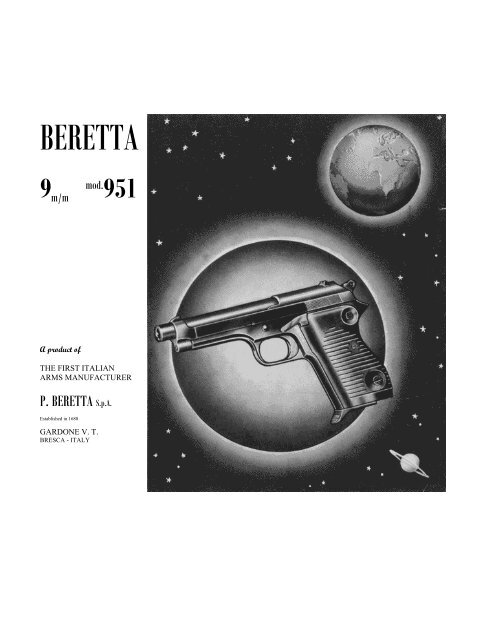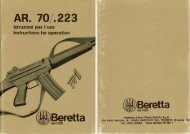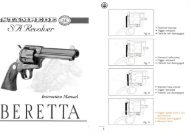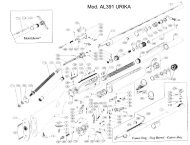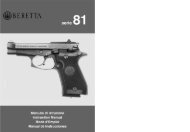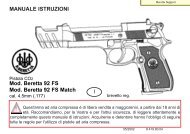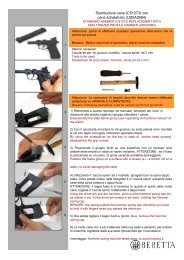Create successful ePaper yourself
Turn your PDF publications into a flip-book with our unique Google optimized e-Paper software.
BERETTA<br />
9 m/m<br />
mod. <strong>951</strong><br />
A product of<br />
THE FIRST ITALIAN<br />
ARMS MANUFACTURER<br />
P. BERETTA S.p.A.<br />
Established in 1680<br />
GARDONE V. T.<br />
BRESCA - ITALY
Beretta Model <strong>951</strong><br />
automatic pistol Beretta model <strong>951</strong><br />
2
Beretta Model <strong>951</strong><br />
Preface<br />
The definite adoption of the 9 mm calibre " parabellum " for the automatic pistols issued to the Armed<br />
Forces and Police detachments during the last war, was not only caused by the necessity to unify the<br />
calibres of pistols and light machine guns (especially Sten gun type), of ever increasing diffusion with the<br />
Armed Forces of the various countries, but also by the excellent ballistic characteristics of this calibre.<br />
The difficulties in supply and adequate training as well as the serious inconveniencies produced in the<br />
logistical sector of operating units, and caused by the existing differences in calibre of the small arms, are<br />
well known.<br />
This need for the unification of the small arms calibres was felt most strongly by the Navy and Air-Craft<br />
Forces it their special detachments often engaged in isolated raids, landing operations, <strong>com</strong>mand actions,<br />
police service, etc. And the considerable supply difficulties aggravated by the special displacements of<br />
these units (such as bridgeheads, ports, observation points, airports, etc.) made it necessary to reduce the<br />
types of ammunition to be issued to each group to the absolute minimum.<br />
To satisfy above-mentioned requirements the " Pietro Beretta " Weapon Factory decided to study and to<br />
realize a " 9 mm. long " calibre automate pistol, answering to the above characteristics, and which does<br />
represent not only the experiences gained by its staff in the manufacture of over 2 million pistols, but also<br />
the results of the studies and experiences of the best foreign industries.<br />
This pistol uses as locking device a vertically sliding, catch, the recharging system is based upon the<br />
recoil of the barrel; both operations have already been proved with excellent results by the construction<br />
technique here and in the best foreign industries. The system presents, in addition, and <strong>com</strong>pared with<br />
that based upon fixed barrel and single gas utilization, with equal cartridge and weight, the considerable<br />
advantage of a sensible reduction of the recoil speed with the consequent reduction in the jumping of the<br />
weapon during the firing. Outstanding are the excellent results obtained through the use of the light alloy<br />
"Ergal" in the manufacture of the body, which made possible the reduction of the weight of the 9 mm long<br />
to an only 0,720 kg. (25.4 ozs), using at the same time the ammunition of the light machine gun which is<br />
considerable more powerful than the normal 9 mm. long ammunition as used before the war. The<br />
weapon, despite its reduced weight, has been especially studied for this ammunition which develops a<br />
maximum pressure of 2100 kg/cm' (29,862 Ibs/sq.in.).<br />
The cartridge, weighing 7,45 g. (0.25 ozs), possesses an initial speed of 340 m/sec (1164 ft/sec) with a<br />
considerable stopping power up to 150-200 m. (500-650 ft).<br />
The 9 mm. short pistol, which forms part of standard equipment of the Italian Army, weighs 0,710 kg. (25.1<br />
ozs), its cartridge, of 6 g. weight (0.21 ozs), develops a pressure off 1200 kg/CM2 (17,064 lbs/sq. in.) with<br />
an initial speed of 280 m/sec (920 ft/sec). Thus the 9 mm. long, though only very slightly heavier,<br />
possesses by far superior ballistic characteristics.<br />
The experiences of the recent Korean war proved that an individual defense weapon of high ballistic<br />
qualities is still required, the more so against the dangers of enemy raids and partisan warfare met with<br />
during the supply and contact service, and which demands a ready reaction based upon efficient weapons<br />
of outstanding offensive power.<br />
Modern warfare, in fact, created the phenomena of guerrilla warfare which takes place at the flanks, of the<br />
operational army units, and the use of pistols and light machine guns, despite the development of new<br />
weapons possessing a very high destructive power, cannot yet be considered as obsolete even in modern<br />
theatres of war.<br />
3
Beretta Model <strong>951</strong><br />
Main Characteristics<br />
System<br />
Operation<br />
Magazines<br />
Weight<br />
Caliber<br />
Recoil barrel locked by a vertically sliding catch<br />
Standard magazine charge: 8 rounds<br />
Special magazine charge: 10 rounds (a further round may be placed into the<br />
chamber)<br />
Weight of the weapon with magazine (but without holster'):<br />
Steel (frame) body: 890 g. (31.4 ozs)<br />
Ergal (frame) body: 720 g. (25.4 ozs)<br />
Calibre: 9 mm.<br />
Cartridge: 9 long standard for pistols and machine pistols «(parabellum ») or sub -<br />
machine guns<br />
Maximum recoil speed of bolt approx. 7,5 m/sec (24.6 ft/sec')<br />
Weight of cartridge: 7,45 g. (0.25 ozs)<br />
Weight of charge: 0,39 g. (6 grains)<br />
Initial speed V 10: approx. 340 m/sec (1164 ft/sec)<br />
Maximum gas pressure: 2100 kg/CM2 (29,862 lbs/ sq. in.)<br />
4
Beretta Model <strong>951</strong><br />
Nomenclature<br />
Bolt Assembly<br />
Bolt, Barrel, Locking Block, Recoil<br />
spring, Recoil spring guide<br />
Barrel Assembly<br />
Barrel Locking Block<br />
Recoil spring Recoil spring guide<br />
Body (Frame) Assembly<br />
Magazine Assembly<br />
5
Beretta Model <strong>951</strong><br />
Main Parts<br />
1 Body 14 Sear ever 27 Ejector p in 40 Check Screws<br />
15 Sear Lever and Safety Catch<br />
2 Bolt 28 Magazine Chamber 41 Right Check<br />
Spring<br />
29 Magazine Spring (Feeder<br />
3 Barrel 16 Sear Lever Pivot 42 Left Check<br />
Spring)<br />
4 Percussion Pin 17 Trigger 30 Magazine Feeder 43 Bolt Catch Lever<br />
44 Bolt Catch Lever Spring<br />
5 Percussion Pin Spring 18 Trigger Lever 31 Magazine Base<br />
Screw<br />
6 Extractor 19 Trigger Lever Spring 32 Base Plate 45 Bolt Catch Lever Spring<br />
7 Extractor Spring 20 Trigger Lever Spring Rod 33 Magazine Catch Button 46 Trigger Pivot<br />
8 Extractor Pin 21 Trigger Lever Pivot 34 Magazine Catch Spring 47 Bolt Catch Lever Pin<br />
9 Hammer 22 Trigger Lever Disengaging Rod 35 Magazine Catch 48 Safety Catch<br />
10 Hammer Spring Rod 23 Disassembling Catch 36 Locking Catch 49 Rear Sight<br />
11 Hammer Spring 24 Recoil Spring Rod 37 Locking Catch Control Pin 50 Locking Catch Spring<br />
12 Hammer Pivot 25 Recoil Spring 38 Control Pin Screw 39 Catch Screw<br />
13 Hammer Spring Rod Support 26 Ejector<br />
6
Beretta Model <strong>951</strong><br />
Instructions<br />
Grip the pistol with the right hand and with the left<br />
introduce the magazine pushing it well into the<br />
chamber until it is locked by the catch. Grip the bolt by<br />
the checkered part pulling it back with a quick move,<br />
then let it snap forward (this operation will be<br />
accelerated by previously lowering the hammer). The<br />
weapon is now loaded and ready to be fired.<br />
Pulling now the trigger the trigger lever is pushed back<br />
against the hammer catch and throws it over, liberating<br />
thus the hammer which, in turn, is pushed forward by<br />
its <strong>com</strong>pressed spring hitting the percussion pin and<br />
firing the weapon.<br />
The firing mechanism of this weapon differs from previous Beretta models in that it presents a very high<br />
sensibility without, however, the danger of any untimely firing. This model, like the other models,<br />
possesses a hammer controlled by two catches, of which the first one, the safety catch, stops the hammer<br />
in case of insufficient lifting; preventing thus that it hits the percussion pin.<br />
After the firing of a round the expanding gases act against the cartridge case pushing it and the bolt<br />
together with the barrel, tightly locked to it, backwards.<br />
After a backward movement of about 7 mm. (1/4 inch) pin (37) provided in the rear end of the barrel hits<br />
against an angle of the body and, acting with its front end against the inclined recess at the lower part of<br />
the locking catch, forces the latter to turn downwards, and to introduce its lateral guides into the slots<br />
provided on the bolt. The backward movement of the barrel is stopped, while the bolt continues its recoil<br />
effecting at the same time the extraction and ejection of the empty case.<br />
The duration of the recoil of the barrel-bolt group has been studied in such a way that, at the moment of<br />
the disconnection of the locking catch the bullet has already left the mouth of the pistol and the gases<br />
have been <strong>com</strong>pletely dispersed.<br />
The recoil spring is <strong>com</strong>pressed by the backward movement of the bolt, at the same time, the hammer is<br />
turned back and grips the sear lever so that the weapon is again ready.<br />
Completed the recoil, the recoil spring carries the bolt again forwards. During this move the bolt grips a<br />
round from the magazine and introduces it into the chamber, carrying at the same time the barrel forward<br />
to its original position while the locking catch, forced by the inclined recess at the lower side, which slides<br />
on a corresponding inclined surface, is turned upwards introducing its guides into the respective slots<br />
provided on the bolt.<br />
The trigger lever, during the recoil of the bolt, has been forced down by the disconnecting lever (22)<br />
(controlled by the ribs of the bolt), and is thus disengaged from the sear lever which returns into its original<br />
position. Thus a continuous uncontrolled firing of the weapon is made impossible even if the pressure is<br />
kept by mistake upon the trigger. Leaving the trigger free, its lever is lifted and reengages the sear lever<br />
pivot; the weapon is again ready to be fired. Renewing successively the pressure upon the trigger, the<br />
above described operations will repeat themselves and the weapon will fire until the magazine is emptied.<br />
Empty magazine:<br />
As soon as the last round is fired and its case ejected, the magazine feeder will lift the bolt stopping catch<br />
and fix the bolt in the recoil position; the weapon will thus remain open and the inconvenience, found with<br />
other pistols, that the feeder of the empty magazine be<strong>com</strong>es blocked between body and bolt, with the<br />
7
Beretta Model <strong>951</strong><br />
subsequent difficulty of the extraction of the magazine case, is prevented. To reload the weapon pull out<br />
the empty magazine case, insert a full magazine and push the checkered button of bolt stopping lever<br />
downwards; the latter, sliding down, will disengage the bolt which slides again forwards, introducing at the<br />
same time a new round from the magazine into the chamber of the barrel. The weapon is ready to be<br />
fired. This return of the bolt into forward position could also be affected by "ripping the checkered part of<br />
the bolt and drawing it back. The lever, pushed by its spring, will slide down and disengage the bolt. (see<br />
figure 5).<br />
Round in barrel:<br />
With a round in the barrel the end of the extractor remains slightly lifted and covers a red-marked sign; the<br />
position can also be felt by touch only.<br />
Safety catch:<br />
The safety catch has been designed to function only with loaded hammer, it blocks at the same time the<br />
hammer and the sear lever. Pushing the button of the catch from right to left the catch will engage the two<br />
devices, pushing from the left to the right; they will be disengaged at the same moment.<br />
This device has been studied to allow maximum speed to obtain the firing position, i. e., by simply pushing<br />
the button with the thumb of the hand holding the weapon. The location of the button is such that, an<br />
involuntary passage from the safe to the firing position is practically impossible.<br />
With the weapon not in ready position the safety catch need not be engaged as the percussion pin is<br />
<strong>com</strong>pletely blocked and kept in this position by its spring without extruding into -the breech: with a round in<br />
the barrel the weapon could not fire even if the hammer should be pulled by accident.<br />
8
Beretta Model <strong>951</strong><br />
Disassembling<br />
Disassembling of the weapon is carried out as<br />
follows:<br />
1) make sure that the weapon is unloaded by<br />
observing the position of the extractor end;<br />
2) pull the hammer<br />
3) pull the magazine out<br />
4) grip the pistol with the left hand and, with the<br />
left hand, push the bolt back until the recess<br />
cut into the right side of the bolt corresponds to<br />
the position of the disassembling catch (figure<br />
6);<br />
5) stop the bolt with the fore-finger of the left hand<br />
in this position to allow the turning of the<br />
checkered button of the disassembling catch;<br />
6) turn the button by a quarter turn in direction of<br />
the arrow etched into the body (see figure 7).<br />
Barrel and bolt are now disengaged and can be<br />
easily slid off the body. To disengage the bolt from<br />
the barrel, take out the recoil spring and press the<br />
button which operates the locking catch. The barrel<br />
will then easily slide off the guides. For reassembly<br />
repeat the same operations starting with the last;<br />
rotating first the checkered assembling catch button<br />
into the position shown on figure 7.<br />
Cleaning<br />
The weapon, when not too dirty, can be cleaned easily, and it is<br />
quite sufficient to disassemble the barrel, the locking catch, bolt,<br />
the recoil spring, and recoil spring guide.<br />
It is, however, necessary to clean the barrel after the use of the<br />
pistol, if possible, by washing it with petrol or kerosene, drying<br />
well and carefully, and oiling slightly with non-acid oil (Vaseline,<br />
neutral oil, etc.).<br />
Should the weapon, however, be very dirty, covered with dust,<br />
dirt, or show traces of rust, it will have to be <strong>com</strong>pletely<br />
disassembled; then all parts have to be thoroughly washed as<br />
before and dried with soft rags. After <strong>com</strong>pletely cleaning, oil<br />
slightly with Vaseline or neutral oil.<br />
9
Beretta Model <strong>951</strong><br />
Maintenance<br />
The main rules to keep the weapon in good firing order are:<br />
1. check the barrel before firing and control the functioning of the various parts;<br />
2. control the magazine for possible deformations, especially along the lips, and check the regular<br />
functioning of the feeder spring;<br />
3. should a stoppage occur, stop firing and act as instructed below;<br />
4. inspect the weapon after firing, clean and oil.<br />
Stoppages<br />
The most important stoppages which may occur are: misfire - in<strong>com</strong>plete locking - missed feeding -<br />
blocked cartridge case - blocked round.<br />
Misfire<br />
This trouble can be caused by deformation or rupture of the percussion pin, by a weak hammer spring,<br />
defects of the round, by dried oil, dirt, or other material blocking the free sliding of the percussion pin, by<br />
in<strong>com</strong>plete locking caused by a weak recoil spring or dried oil and dirt in the grooves of the bolt. Recharge<br />
hammer and repeat the firing. Should the stoppage re-occur, eject cartridge from the barrel by pulling the<br />
bolt back. If the stoppage continues, control the parts indicated above and substitute those which are<br />
damaged, used, or broken.<br />
In<strong>com</strong>plete locking<br />
In<strong>com</strong>plete locking can he caused by weakness or rupture of the recoil spring, or by dried oil and dirt in<br />
the grooves of the bolt guides, on the surfaces of the locking catch slide planes, or in other devices<br />
controlling the functioning of the various parts.<br />
Unload weapon, cheek spring and change if required: if necessary, clean the weapon with special<br />
attention to the grooves and planes.<br />
Missed feeding<br />
Missed feeding is caused by a weak feeder spring, damaged magazine case, or faulty functioning of the<br />
magazine locking catch. - check and replace as required the faulty parts.<br />
Blocked - cartridge case<br />
The cartridge case can be blocked by faulty functioning of the ejector or extractor or the respective spring;<br />
by in<strong>com</strong>plete recoil of the bolt due to foreign matter in the sliding grooves: take out the magazine, pull the<br />
bolt back and shake the case out, cheek ejector and spring and change if faulty; at the same time clean<br />
the grooves.<br />
Blocked round<br />
Take out the blocked round; if the stoppage repeats cheek the functioning of the feeder spring, the lips of<br />
the magazine for possible damage; change whatever parts may be damaged. Control also the magazine<br />
locking each.<br />
10<br />
reprint by: shue


